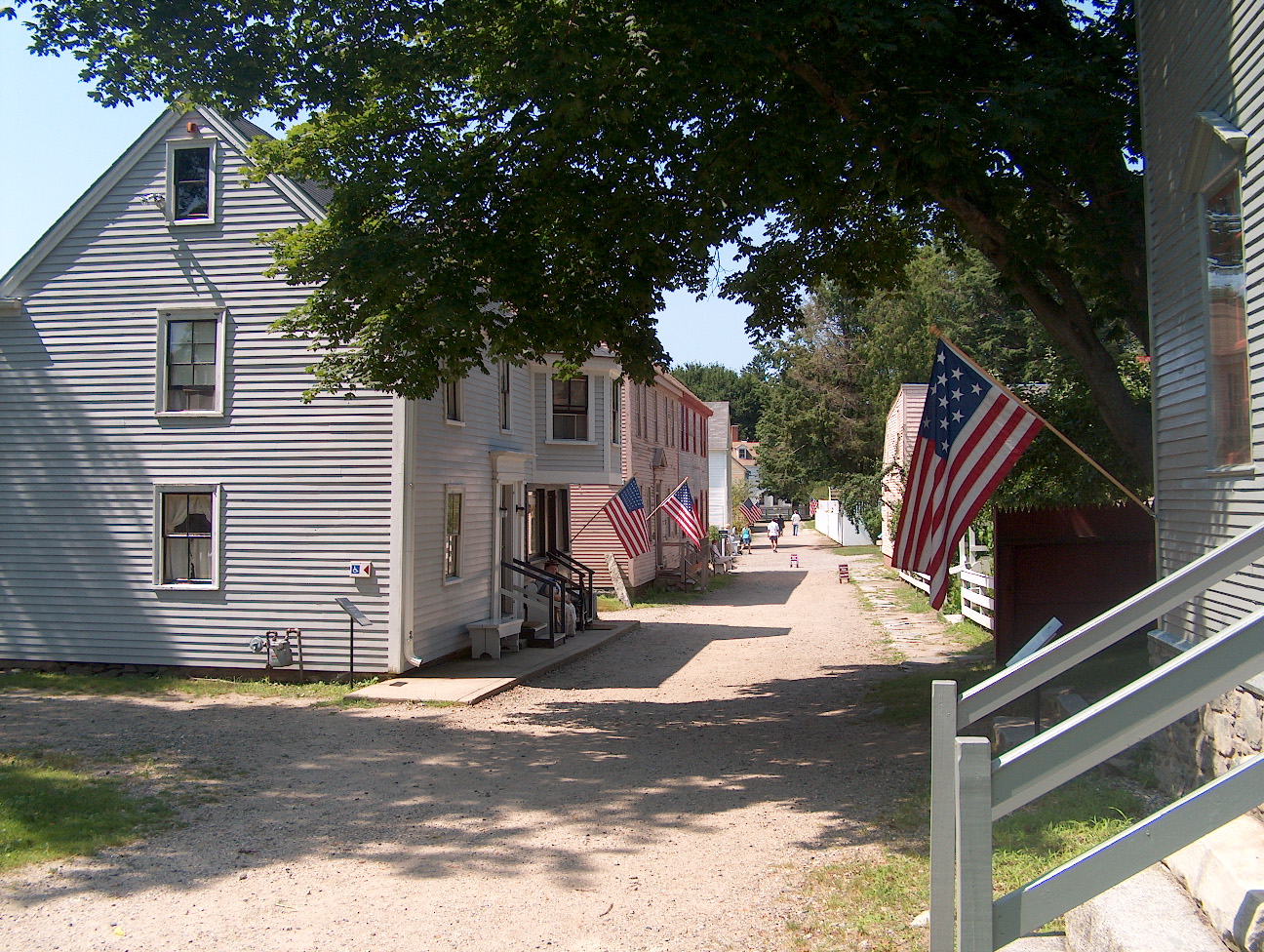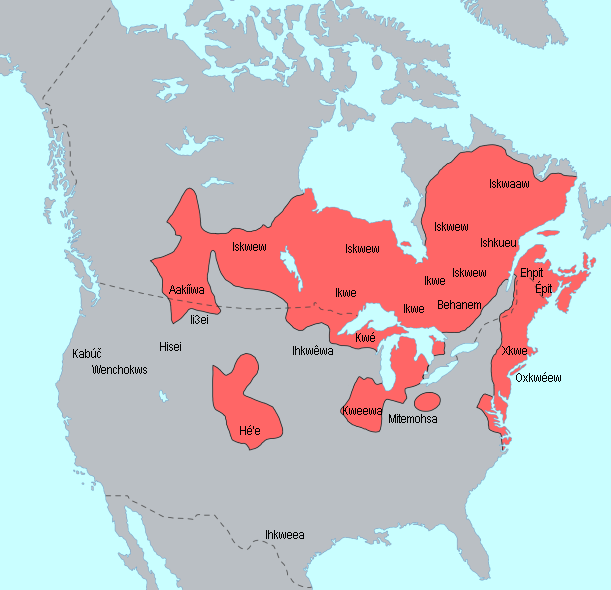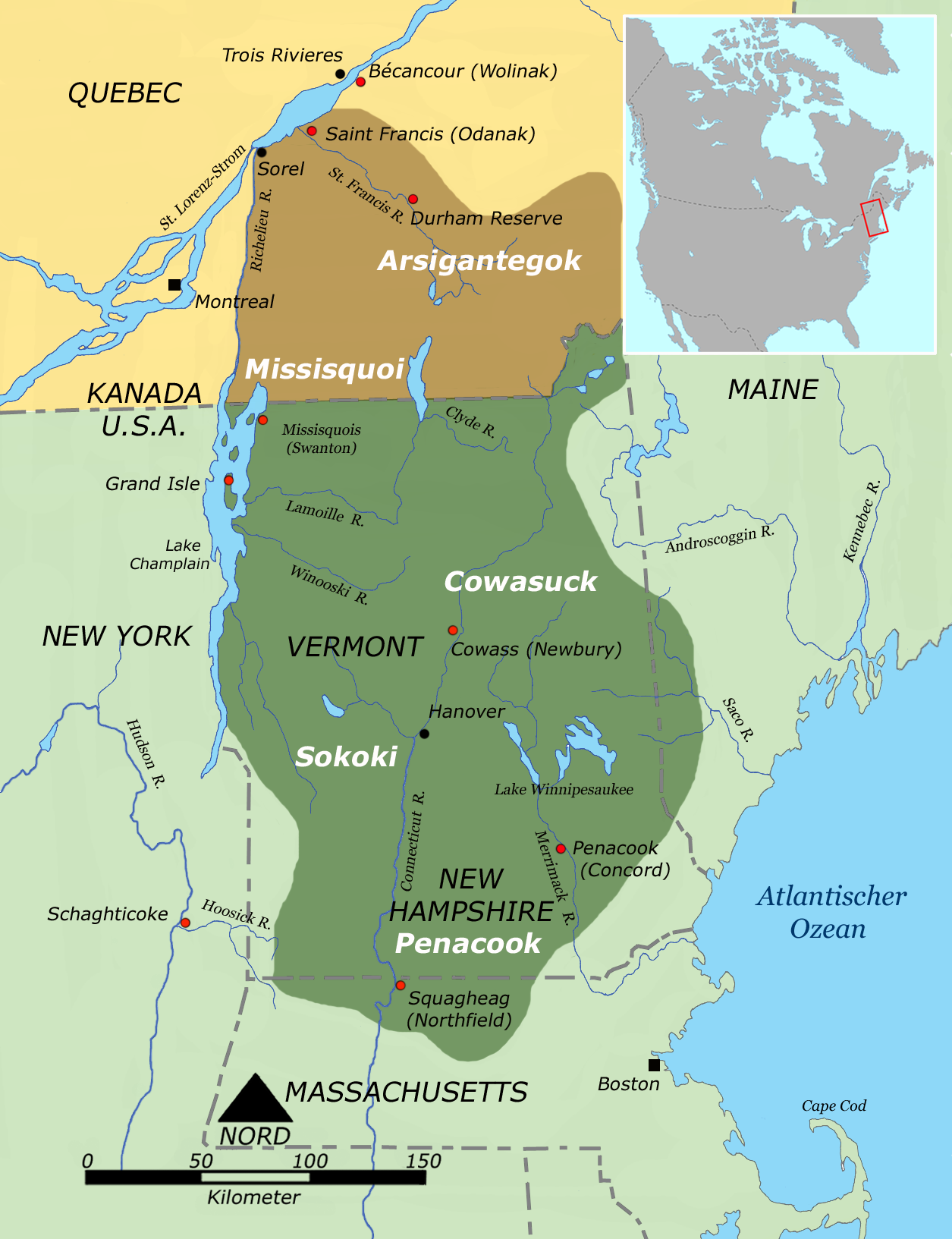|
Portsmouth, NH
Portsmouth is a city in Rockingham County, New Hampshire, United States. At the 2020 census it had a population of 21,956. A historic seaport and popular summer tourist destination on the Piscataqua River bordering the state of Maine, Portsmouth was formerly the home of the Strategic Air Command's Pease Air Force Base, since converted to Portsmouth International Airport at Pease. History American Indians of the Abenaki and other Algonquian languages-speaking nations, and their predecessors, inhabited the territory of coastal New Hampshire for thousands of years before European contact. The first known European to explore and write about the area was Martin Pring in 1603. The Piscataqua River is a tidal estuary with a swift current, but forms a good natural harbor. The west bank of the harbor was settled by European colonists in 1630 and named Strawbery Banke, after the many wild strawberries growing there. The village was protected by Fort William and Mary on what is now ... [...More Info...] [...Related Items...] OR: [Wikipedia] [Google] [Baidu] |
North Church (Portsmouth, New Hampshire)
The North Church of Portsmouth, New Hampshire, Portsmouth, New Hampshire, United States, is a historic Congregationalism in the United States, Congregational church located in Market Square. Sited directly across from the Portsmouth Athenæum, it features an Italianate edifice and a steeple visible from most of the city, the Piscataqua River, and communities on its western bank in Maine. Its spire has been referred to as Portsmouth's "landmark of record". The church is home to Portsmouth's United Church of Christ congregation. History The first church built in Portsmouth was constructed in 1657 near a milldam. Another church building was built on a corner of the same glebe at the corner of Congress Street and Pleasant Street roughly fifty years later. A large clock and bell were added in 1749. The church kept extensive records of baptisms, marriages, and funerals of members. Prominent members included William Whipple, John Langdon (politician), John Langdon, and Daniel Webster. ... [...More Info...] [...Related Items...] OR: [Wikipedia] [Google] [Baidu] |
United States
The United States of America (USA), also known as the United States (U.S.) or America, is a country primarily located in North America. It is a federal republic of 50 U.S. state, states and a federal capital district, Washington, D.C. The 48 contiguous states border Canada to the north and Mexico to the south, with the semi-exclave of Alaska in the northwest and the archipelago of Hawaii in the Pacific Ocean. The United States asserts sovereignty over five Territories of the United States, major island territories and United States Minor Outlying Islands, various uninhabited islands in Oceania and the Caribbean. It is a megadiverse country, with the world's List of countries and dependencies by area, third-largest land area and List of countries and dependencies by population, third-largest population, exceeding 340 million. Its three Metropolitan statistical areas by population, largest metropolitan areas are New York metropolitan area, New York, Greater Los Angeles, Los Angel ... [...More Info...] [...Related Items...] OR: [Wikipedia] [Google] [Baidu] |
Fragaria
''Fragaria'' () is a genus of flowering plants in the rose family, Rosaceae, commonly known as strawberries for their edible fruits. There are more than 20 described species and many Hybrid plant, hybrids and cultivars. The most common strawberries grown commercially are cultivars of the strawberry, garden strawberry, a hybrid known as ''Fragaria'' × ''ananassa''. Strawberries have a taste that varies by cultivar, and ranges from quite sweet to rather tart. Strawberries are an important commercial fruit crop, widely grown in all temperate regions of the world. Description Strawberries are not Berry (botany), berries in the botanical sense.Esau, K. 1977. ''Anatomy of seed plants''. John Wiley and Sons, New York. The fleshy and edible part of the "fruit" is a receptacle (botany), receptacle, and the parts that are sometimes mistakenly called "seeds" are achenes and therefore the true botanical fruits. Etymology The genus name derives from ("strawberry") and , a suffix used to c ... [...More Info...] [...Related Items...] OR: [Wikipedia] [Google] [Baidu] |
Strawbery Banke
Strawbery Banke is an outdoor history museum located in the South End historic district of Portsmouth, New Hampshire. It is the oldest neighborhood in New Hampshire to be settled by Europeans, and the earliest neighborhood remaining in the present-day city of Portsmouth. It features more than 37 restored buildings built between the 17th and 19th centuries in the Colonial, Georgian, and Federal style architectures. The buildings once clustered around a waterway known as Puddle Dock, which was filled in around 1900. Today the former waterway appears as a large open space. History The neighborhood's history goes back to 1630, when Captain Walter Neale chose the area to build a settlement, naming it after the wild berries growing along the Piscataqua River. In 1631, Humphrey Chadborn constructed the Great House, marking the first permanent English building in the neighborhood. Subsequent housing and an influx of English ships led the tidal inlet port at Strawbery Banke to be k ... [...More Info...] [...Related Items...] OR: [Wikipedia] [Google] [Baidu] |
Estuary
An estuary is a partially enclosed coastal body of brackish water with one or more rivers or streams flowing into it, and with a free connection to the open sea. Estuaries form a transition zone between river environments and maritime environments and are an example of an ecotone. Estuaries are subject both to marine influences such as tides, waves, and the influx of saline water, and to fluvial influences such as flows of freshwater and sediment. The mixing of seawater and freshwater provides high levels of nutrients both in the water column and in sediment, making estuaries among the most productive natural habitats in the world. Most existing estuaries formed during the Holocene epoch with the flooding of river-eroded or glacially scoured valleys when the sea level began to rise about 10,000–12,000 years ago. Estuaries are typically classified according to their geomorphological features or to water-circulation patterns. They can have many different names, such as ba ... [...More Info...] [...Related Items...] OR: [Wikipedia] [Google] [Baidu] |
Martin Pring
Martin Pring (1580–1626) was an English explorer from Bristol, England who in 1603 at the age of 23 was captain of an expedition to North America to assess commercial potential; he explored areas of present-day Maine, New Hampshire, and Cape Cod in Massachusetts. Pring and his crew were the first known Europeans to ascend the Piscataqua River. It is thought that Italian explorer Giovanni da Verrazzano explored this part of the New England coast in 1524-25 looking for a route to the Far East, but he did not make landfall until he reached the St. Lawrence River further north. In 1606 Pring returned to America and mapped the Maine coast. Later he became a ship's master, sailing for the East India Company and exploring in East Asia. He also prevented other nations from trading in the area. By 1619 he commanded all the Company's naval forces. Returning to England in 1621, Pring was made a member of the Virginia Company and granted land in the Chesapeake Bay area. After leaving the E ... [...More Info...] [...Related Items...] OR: [Wikipedia] [Google] [Baidu] |
Algonquian Languages
The Algonquian languages ( ; also Algonkian) are a family of Indigenous languages of the Americas and most of the languages in the Algic language family are included in the group. The name of the Algonquian language family is distinguished from the orthographically similar Algonquin dialect of the Indigenous Ojibwe language (Chippewa), which is a senior member of the Algonquian language family. The term ''Algonquin'' has been suggested to derive from the Maliseet word (), meaning 'they are our relatives/allies'. Speakers of Algonquian languages stretch from the east coast of North America to the Rocky Mountains. The proto-language from which all of the languages of the family descend, Proto-Algonquian, was spoken around 2,500 to 3,000 years ago. There is no scholarly consensus about where this language was spoken. Family division This subfamily of around 30 languages is divided into three groups according to geography: Plains, Central, and Eastern Algonquian. Of t ... [...More Info...] [...Related Items...] OR: [Wikipedia] [Google] [Baidu] |
Abenaki
The Abenaki ( Abenaki: ''Wαpánahki'') are Indigenous people of the Northeastern Woodlands of Canada and the United States. They are an Algonquian-speaking people and part of the Wabanaki Confederacy. The Eastern Abenaki language was predominantly spoken in Maine, while the Western Abenaki language was spoken in Quebec, Vermont, and New Hampshire. While Abenaki peoples have shared cultural traits, they did not historically have a centralized government. They came together as a post-contact community after their original tribes were decimated by colonization, disease, and warfare. Names The word ''Abenaki'' and its syncope, ''Abnaki,'' are both derived from ''Wabanaki'', or ''Wôbanakiak,'' meaning "People of the Dawn Land" in the Abenaki language. While the two terms are often confused, the Abenaki are one of several tribes in the Wabanaki Confederacy. Alternate spellings include: ''Abnaki'', ''Abinaki'', ''Alnôbak'', ''Abanakee'', ''Abanaki'', ''Abanaqui'', ''Abana ... [...More Info...] [...Related Items...] OR: [Wikipedia] [Google] [Baidu] |
Indigenous Peoples Of The Americas
In the Americas, Indigenous peoples comprise the two continents' pre-Columbian inhabitants, as well as the ethnic groups that identify with them in the 15th century, as well as the ethnic groups that identify with the pre-Columbian population of the Americas as such. These populations exhibit significant diversity; some Indigenous peoples were historically hunter-gatherers, while others practiced agriculture and aquaculture. Various Indigenous societies developed complex social structures, including pre-contact monumental architecture, organized city, cities, city-states, chiefdoms, state (polity), states, monarchy, kingdoms, republics, confederation, confederacies, and empires. These societies possessed varying levels of knowledge in fields such as Pre-Columbian engineering in the Americas, engineering, Pre-Columbian architecture, architecture, mathematics, astronomy, History of writing, writing, physics, medicine, Pre-Columbian agriculture, agriculture, irrigation, geology, minin ... [...More Info...] [...Related Items...] OR: [Wikipedia] [Google] [Baidu] |
Portsmouth International Airport At Pease
Portsmouth International Airport at Pease , formerly known as Pease International Airport, is a joint civil and military use airport located one nautical mile (2 km) west of the central business district of Portsmouth, a city in Rockingham County, New Hampshire, United States. It is owned by the Pease Development Authority. It is included in the Federal Aviation Administration (FAA) National Plan of Integrated Airport Systems for 2017–2021, in which it is categorized as a non-hub primary commercial service facility. The airport is located within the Pease International Tradeport, a result of the ongoing redevelopment of the former Pease Air Force Base which was closed under Base Realignment and Closure (BRAC) Commission action in the late 1980s and early 1990s. Usage Military The airport shares its runway with the Pease Air National Guard Base, which is actively utilized by the 157th Air Refueling Wing (157 ARW) of the New Hampshire Air National Guard, an Air Mo ... [...More Info...] [...Related Items...] OR: [Wikipedia] [Google] [Baidu] |
Pease Air Force Base
Pease, in Middle English, was a noun referring to the vegetable pea; see that article for its etymology. The word survives into modern English in pease pudding. Pease may also refer to: People * Pease family (Darlington), a prominent family in Darlington, UK * Al Pease (1921–2014), Formula One driver * Sir Alfred Pease, 2nd Baronet (1857–1939), English Liberal Party politician * Alfred Pease (musician) (1838–1882), composer * Arthur Pease (MP) (1837–1898), English MP * Sir Arthur Pease, 1st Baronet (1866–1927), 1st Baronet and British coal magnate and railway director * Arthur Stanley Pease (1881–1964), U.S. professor of Classics and amateur botanist * Bas Pease (1922–2004), British physicist *Bob Pease (1940–2011), analog integrated circuit design expert * Claire Pease (born 2009), American artistic gymnast * Don Pease (1932–2002), U.S. Representative from Ohio * Edward Pease (other), several people * Elisha M. Pease (1812–1883), Texas governor * Franc ... [...More Info...] [...Related Items...] OR: [Wikipedia] [Google] [Baidu] |
Strategic Air Command
Strategic Air Command (SAC) was a United States Department of Defense Specified Command and a United States Air Force (USAF) Major Command responsible for command and control of the strategic bomber and intercontinental ballistic missile components of the United States military's strategic nuclear weapon, strategic nuclear forces from 1946 to 1992. SAC was also responsible for strategic reconnaissance aircraft; airborne command posts; and most of the USAF's aerial refueling aircraft. SAC primarily consisted of the Second Air Force (2AF), Eighth Air Force (8AF) and the Fifteenth Air Force (15AF), while SAC headquarters (HQ SAC) included Directorates for Operations & Plans, Intelligence, Command & Control, Maintenance, Training, Communications, and Personnel. At a lower echelon, SAC headquarters divisions included Aircraft Engineering, Missile Concept, and Strategic Communications. In 1992, as part of an overall post-Cold War reorganization of the U.S. Air Force, SAC was disesta ... [...More Info...] [...Related Items...] OR: [Wikipedia] [Google] [Baidu] |





